Confederation College: Guide to Writing Essays and Research Papers
VerifiedAdded on 2023/01/20
|20
|4871
|30
Homework Assignment
AI Summary
This booklet, compiled by Jeanette Johnson Gay Cambly and Susan Miller, serves as a comprehensive guide to writing essays and short research papers, offering valuable insights for students. It begins by emphasizing the importance of verifying instructions and provides a step-by-step approach to essay writing, including choosing a topic, brainstorming, creating outlines, researching, writing rough drafts, and revising. The guide details the essential components of an essay, such as the introduction, body paragraphs, and conclusion, providing examples and explanations for each section, including how to formulate a strong thesis statement. Additionally, it offers practical advice on using transitional words and includes a writer's checklist to ensure quality. The booklet also provides detailed information on MLA and APA formatting styles, including title pages, opening pages, and works cited/references pages, to assist students in properly citing sources and structuring their papers. This resource is designed to assist students in developing their writing skills and producing well-organized and properly formatted essays and research papers.
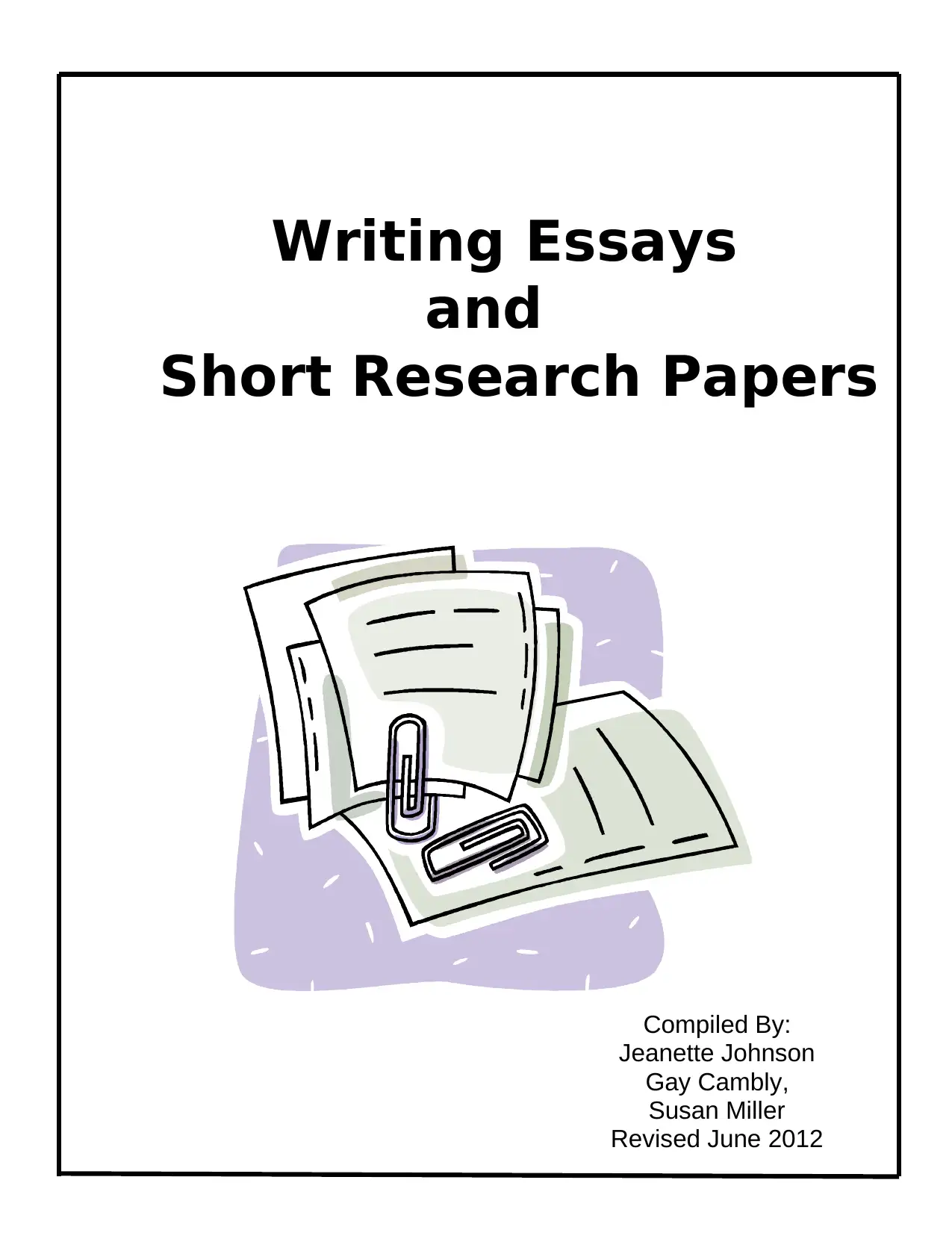
Writing Essays
and
Short Research Papers
Compiled By:
Jeanette Johnson
Gay Cambly,
Susan Miller
Revised June 2012
and
Short Research Papers
Compiled By:
Jeanette Johnson
Gay Cambly,
Susan Miller
Revised June 2012
Paraphrase This Document
Need a fresh take? Get an instant paraphrase of this document with our AI Paraphraser

2
TABLE OF CONTENTS
TABLE OF CONTENTS 2
INTRODUCTION 3
VERIFYING INSTRUCTIONS 4
APPROACH 4
Choose a Topic 5
Brainstorm 5
Tentative Outline 6
Set Deadlines 6
Research 6
Final Outline 6
Rough Draft 7
Revise and Rewrite 7
Proofread Draft 7
Final Copy 7
Proofread Final Copy 7
CONTENT of Essay 8 – 11
Sample Outline 8
Introduction 9
Thesis Statement 9
Sample Thesis Statements 9
Body 10
Summary or Conclusion 10 - 11
Transitional Words 11
A Writer’s Checklist 12
MLA Format 13 - 15
Title Page 13
Opening Page 13
Sample Opening Page 14
Sample Works Cited Page 15
APA Format 16 – 19
Sample First Page 16
General Rules for Reference Page 18
Sample References Page 19
Summary 20
TABLE OF CONTENTS
TABLE OF CONTENTS 2
INTRODUCTION 3
VERIFYING INSTRUCTIONS 4
APPROACH 4
Choose a Topic 5
Brainstorm 5
Tentative Outline 6
Set Deadlines 6
Research 6
Final Outline 6
Rough Draft 7
Revise and Rewrite 7
Proofread Draft 7
Final Copy 7
Proofread Final Copy 7
CONTENT of Essay 8 – 11
Sample Outline 8
Introduction 9
Thesis Statement 9
Sample Thesis Statements 9
Body 10
Summary or Conclusion 10 - 11
Transitional Words 11
A Writer’s Checklist 12
MLA Format 13 - 15
Title Page 13
Opening Page 13
Sample Opening Page 14
Sample Works Cited Page 15
APA Format 16 – 19
Sample First Page 16
General Rules for Reference Page 18
Sample References Page 19
Summary 20
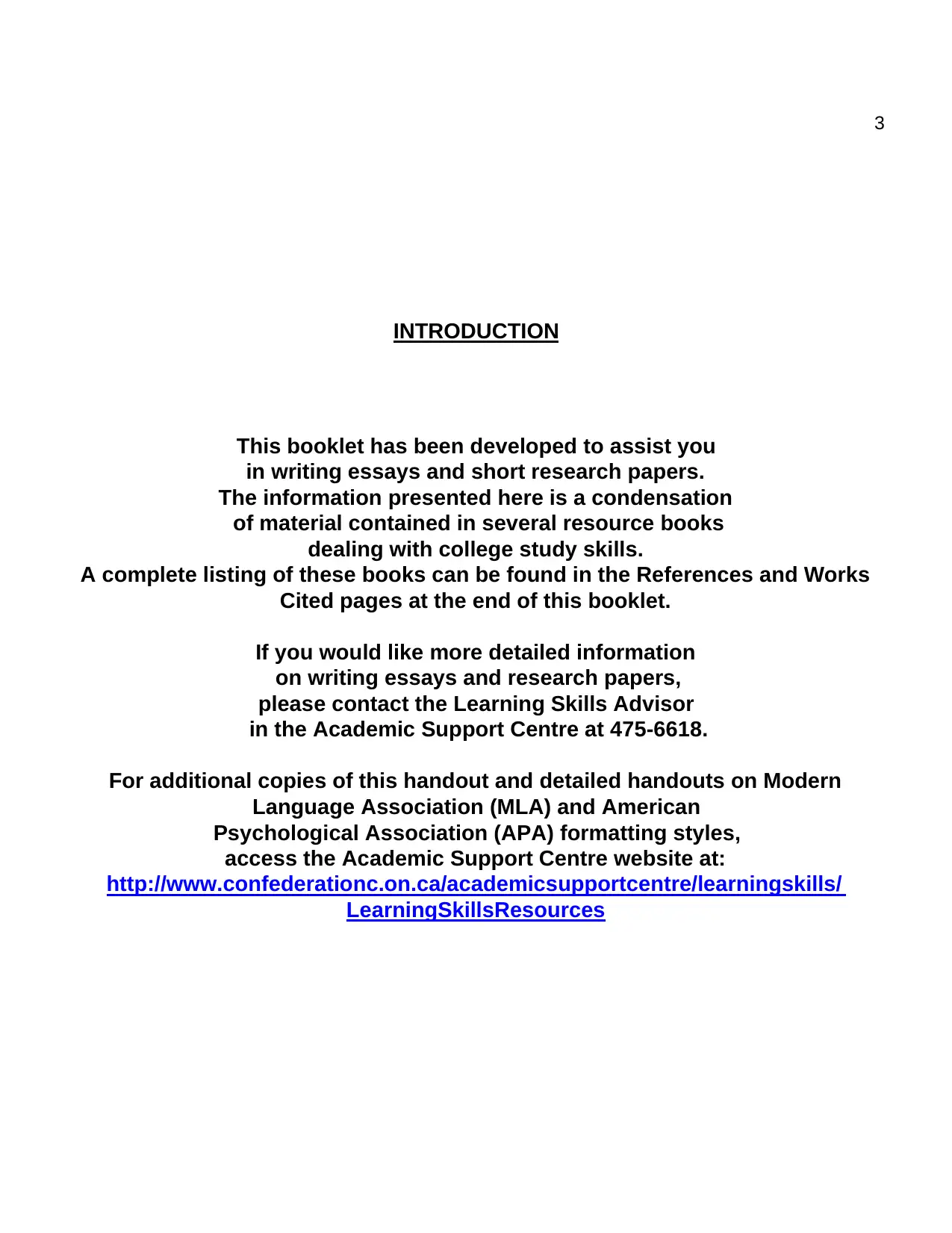
3
INTRODUCTION
This booklet has been developed to assist you
in writing essays and short research papers.
The information presented here is a condensation
of material contained in several resource books
dealing with college study skills.
A complete listing of these books can be found in the References and Works
Cited pages at the end of this booklet.
If you would like more detailed information
on writing essays and research papers,
please contact the Learning Skills Advisor
in the Academic Support Centre at 475-6618.
For additional copies of this handout and detailed handouts on Modern
Language Association (MLA) and American
Psychological Association (APA) formatting styles,
access the Academic Support Centre website at:
http://www.confederationc.on.ca/academicsupportcentre/learningskills/
LearningSkillsResources
INTRODUCTION
This booklet has been developed to assist you
in writing essays and short research papers.
The information presented here is a condensation
of material contained in several resource books
dealing with college study skills.
A complete listing of these books can be found in the References and Works
Cited pages at the end of this booklet.
If you would like more detailed information
on writing essays and research papers,
please contact the Learning Skills Advisor
in the Academic Support Centre at 475-6618.
For additional copies of this handout and detailed handouts on Modern
Language Association (MLA) and American
Psychological Association (APA) formatting styles,
access the Academic Support Centre website at:
http://www.confederationc.on.ca/academicsupportcentre/learningskills/
LearningSkillsResources
⊘ This is a preview!⊘
Do you want full access?
Subscribe today to unlock all pages.

Trusted by 1+ million students worldwide

4
Verifying Instructions
Once you have been assigned to write an essay paper, be sure that you understand all of the
instructions and know exactly what is expected of you.
Be sure you know such things as:
• whether there is an assigned topic or whether you are free to choose one
• type of essay required - e.g. descriptive, narrative, persuasive, explanatory
• the depth to which the instructor wants you to examine the topic
• whether you are required to give your own opinions
• length of the essay ( i.e. number of words or number of pages )
• format required by the instructor, including ( if applicable)
cover page
table of contents
spacing
endnotes or references
works cited
• due date
• how much the essay counts toward your final grade. (This will give you an indication of
the time and effort required).
Approach
The following plan of approach will assist you in completing your assignment. The
steps may be adapted to suit your requirements ( e.g. if the research is not required,
omit step 5 ).
Choose a Topic
If the topic is not assigned, choose a topic.
• Something you are interested in or would like to know more about
• Topic should be relevant to the course ( e.g. don’t write about “Scuba Diving”
for a psychology course )
• Get the teacher’s approval after selecting your topic
Verifying Instructions
Once you have been assigned to write an essay paper, be sure that you understand all of the
instructions and know exactly what is expected of you.
Be sure you know such things as:
• whether there is an assigned topic or whether you are free to choose one
• type of essay required - e.g. descriptive, narrative, persuasive, explanatory
• the depth to which the instructor wants you to examine the topic
• whether you are required to give your own opinions
• length of the essay ( i.e. number of words or number of pages )
• format required by the instructor, including ( if applicable)
cover page
table of contents
spacing
endnotes or references
works cited
• due date
• how much the essay counts toward your final grade. (This will give you an indication of
the time and effort required).
Approach
The following plan of approach will assist you in completing your assignment. The
steps may be adapted to suit your requirements ( e.g. if the research is not required,
omit step 5 ).
Choose a Topic
If the topic is not assigned, choose a topic.
• Something you are interested in or would like to know more about
• Topic should be relevant to the course ( e.g. don’t write about “Scuba Diving”
for a psychology course )
• Get the teacher’s approval after selecting your topic
Paraphrase This Document
Need a fresh take? Get an instant paraphrase of this document with our AI Paraphraser
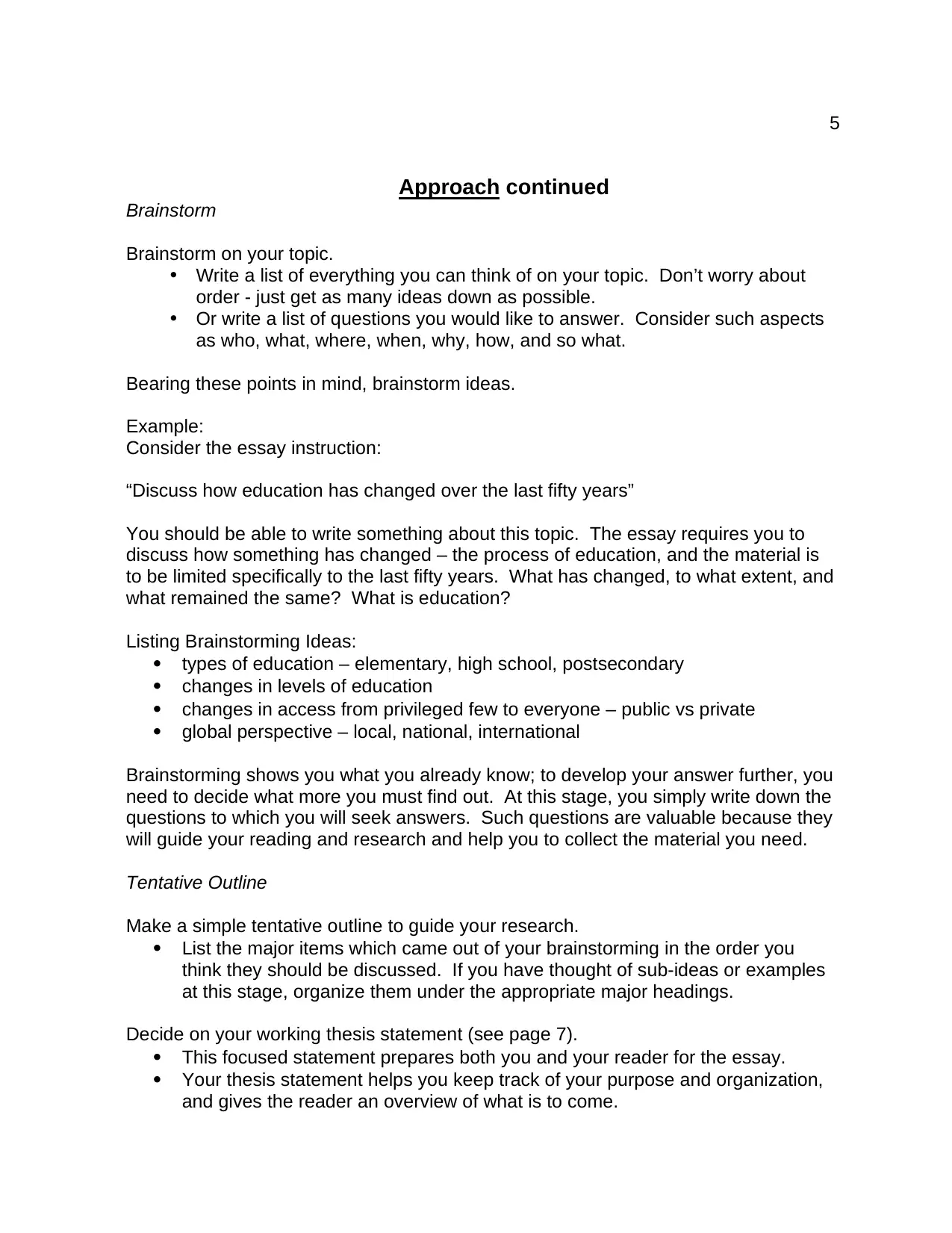
5
Approach continued
Brainstorm
Brainstorm on your topic.
• Write a list of everything you can think of on your topic. Don’t worry about
order - just get as many ideas down as possible.
• Or write a list of questions you would like to answer. Consider such aspects
as who, what, where, when, why, how, and so what.
Bearing these points in mind, brainstorm ideas.
Example:
Consider the essay instruction:
“Discuss how education has changed over the last fifty years”
You should be able to write something about this topic. The essay requires you to
discuss how something has changed – the process of education, and the material is
to be limited specifically to the last fifty years. What has changed, to what extent, and
what remained the same? What is education?
Listing Brainstorming Ideas:
types of education – elementary, high school, postsecondary
changes in levels of education
changes in access from privileged few to everyone – public vs private
global perspective – local, national, international
Brainstorming shows you what you already know; to develop your answer further, you
need to decide what more you must find out. At this stage, you simply write down the
questions to which you will seek answers. Such questions are valuable because they
will guide your reading and research and help you to collect the material you need.
Tentative Outline
Make a simple tentative outline to guide your research.
List the major items which came out of your brainstorming in the order you
think they should be discussed. If you have thought of sub-ideas or examples
at this stage, organize them under the appropriate major headings.
Decide on your working thesis statement (see page 7).
This focused statement prepares both you and your reader for the essay.
Your thesis statement helps you keep track of your purpose and organization,
and gives the reader an overview of what is to come.
Approach continued
Brainstorm
Brainstorm on your topic.
• Write a list of everything you can think of on your topic. Don’t worry about
order - just get as many ideas down as possible.
• Or write a list of questions you would like to answer. Consider such aspects
as who, what, where, when, why, how, and so what.
Bearing these points in mind, brainstorm ideas.
Example:
Consider the essay instruction:
“Discuss how education has changed over the last fifty years”
You should be able to write something about this topic. The essay requires you to
discuss how something has changed – the process of education, and the material is
to be limited specifically to the last fifty years. What has changed, to what extent, and
what remained the same? What is education?
Listing Brainstorming Ideas:
types of education – elementary, high school, postsecondary
changes in levels of education
changes in access from privileged few to everyone – public vs private
global perspective – local, national, international
Brainstorming shows you what you already know; to develop your answer further, you
need to decide what more you must find out. At this stage, you simply write down the
questions to which you will seek answers. Such questions are valuable because they
will guide your reading and research and help you to collect the material you need.
Tentative Outline
Make a simple tentative outline to guide your research.
List the major items which came out of your brainstorming in the order you
think they should be discussed. If you have thought of sub-ideas or examples
at this stage, organize them under the appropriate major headings.
Decide on your working thesis statement (see page 7).
This focused statement prepares both you and your reader for the essay.
Your thesis statement helps you keep track of your purpose and organization,
and gives the reader an overview of what is to come.
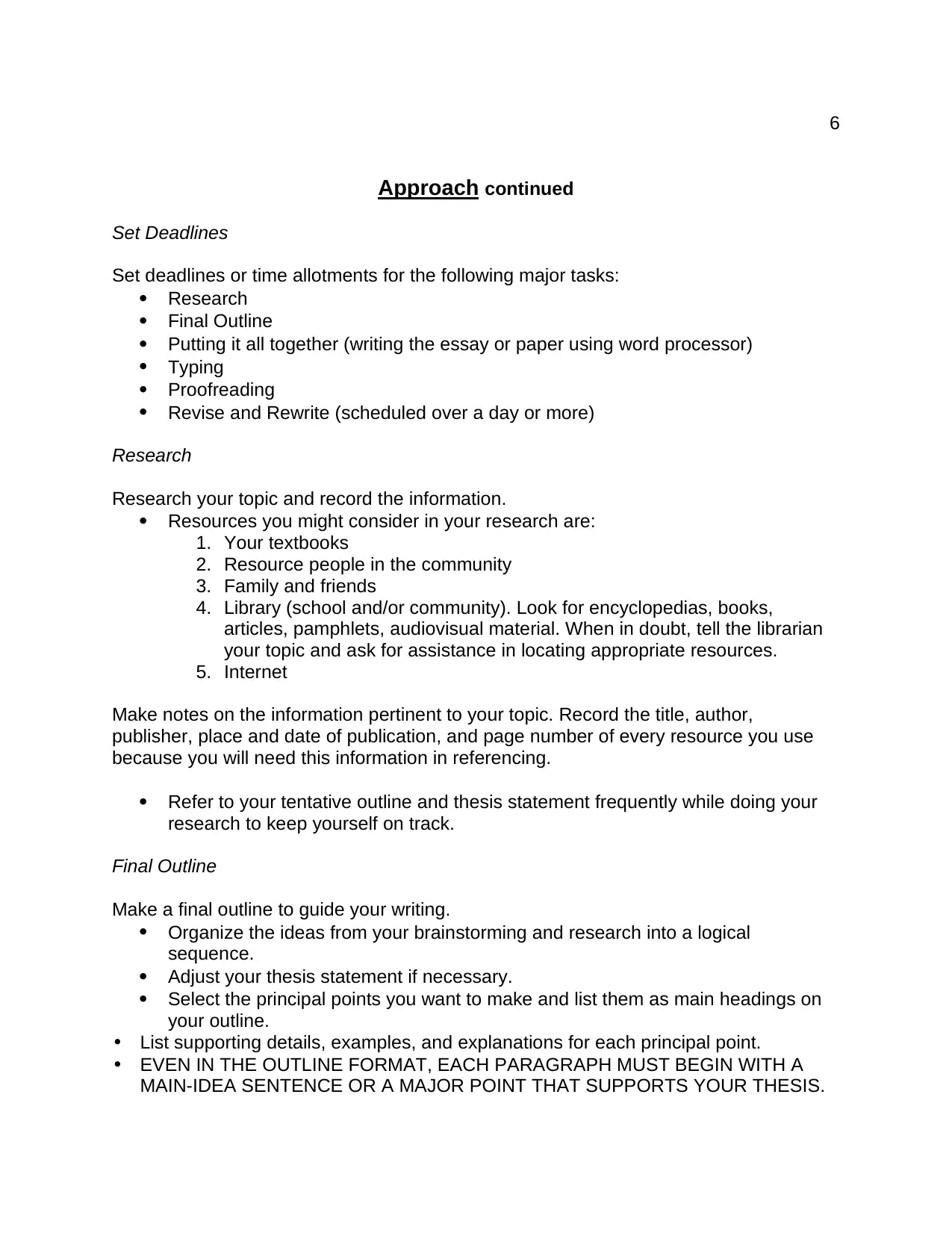
6
Approach continued
Set Deadlines
Set deadlines or time allotments for the following major tasks:
Research
Final Outline
Putting it all together (writing the essay or paper using word processor)
Typing
Proofreading
Revise and Rewrite (scheduled over a day or more)
Research
Research your topic and record the information.
Resources you might consider in your research are:
1. Your textbooks
2. Resource people in the community
3. Family and friends
4. Library (school and/or community). Look for encyclopedias, books,
articles, pamphlets, audiovisual material. When in doubt, tell the librarian
your topic and ask for assistance in locating appropriate resources.
5. Internet
Make notes on the information pertinent to your topic. Record the title, author,
publisher, place and date of publication, and page number of every resource you use
because you will need this information in referencing.
Refer to your tentative outline and thesis statement frequently while doing your
research to keep yourself on track.
Final Outline
Make a final outline to guide your writing.
Organize the ideas from your brainstorming and research into a logical
sequence.
Adjust your thesis statement if necessary.
Select the principal points you want to make and list them as main headings on
your outline.
• List supporting details, examples, and explanations for each principal point.
• EVEN IN THE OUTLINE FORMAT, EACH PARAGRAPH MUST BEGIN WITH A
MAIN-IDEA SENTENCE OR A MAJOR POINT THAT SUPPORTS YOUR THESIS.
Approach continued
Set Deadlines
Set deadlines or time allotments for the following major tasks:
Research
Final Outline
Putting it all together (writing the essay or paper using word processor)
Typing
Proofreading
Revise and Rewrite (scheduled over a day or more)
Research
Research your topic and record the information.
Resources you might consider in your research are:
1. Your textbooks
2. Resource people in the community
3. Family and friends
4. Library (school and/or community). Look for encyclopedias, books,
articles, pamphlets, audiovisual material. When in doubt, tell the librarian
your topic and ask for assistance in locating appropriate resources.
5. Internet
Make notes on the information pertinent to your topic. Record the title, author,
publisher, place and date of publication, and page number of every resource you use
because you will need this information in referencing.
Refer to your tentative outline and thesis statement frequently while doing your
research to keep yourself on track.
Final Outline
Make a final outline to guide your writing.
Organize the ideas from your brainstorming and research into a logical
sequence.
Adjust your thesis statement if necessary.
Select the principal points you want to make and list them as main headings on
your outline.
• List supporting details, examples, and explanations for each principal point.
• EVEN IN THE OUTLINE FORMAT, EACH PARAGRAPH MUST BEGIN WITH A
MAIN-IDEA SENTENCE OR A MAJOR POINT THAT SUPPORTS YOUR THESIS.
⊘ This is a preview!⊘
Do you want full access?
Subscribe today to unlock all pages.

Trusted by 1+ million students worldwide
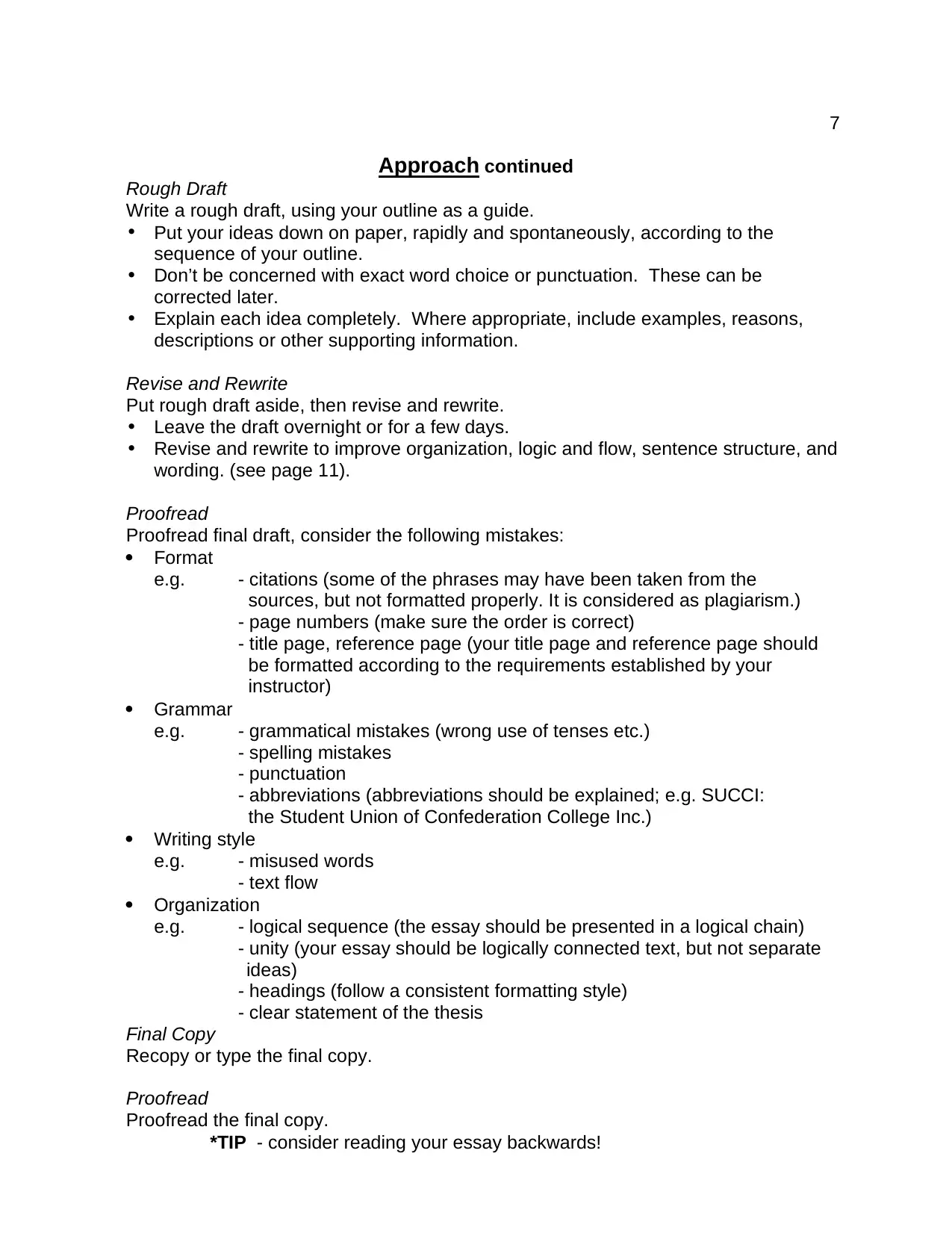
7
Approach continued
Rough Draft
Write a rough draft, using your outline as a guide.
• Put your ideas down on paper, rapidly and spontaneously, according to the
sequence of your outline.
• Don’t be concerned with exact word choice or punctuation. These can be
corrected later.
• Explain each idea completely. Where appropriate, include examples, reasons,
descriptions or other supporting information.
Revise and Rewrite
Put rough draft aside, then revise and rewrite.
• Leave the draft overnight or for a few days.
• Revise and rewrite to improve organization, logic and flow, sentence structure, and
wording. (see page 11).
Proofread
Proofread final draft, consider the following mistakes:
Format
e.g. - citations (some of the phrases may have been taken from the
sources, but not formatted properly. It is considered as plagiarism.)
- page numbers (make sure the order is correct)
- title page, reference page (your title page and reference page should
be formatted according to the requirements established by your
instructor)
Grammar
e.g. - grammatical mistakes (wrong use of tenses etc.)
- spelling mistakes
- punctuation
- abbreviations (abbreviations should be explained; e.g. SUCCI:
the Student Union of Confederation College Inc.)
Writing style
e.g. - misused words
- text flow
Organization
e.g. - logical sequence (the essay should be presented in a logical chain)
- unity (your essay should be logically connected text, but not separate
ideas)
- headings (follow a consistent formatting style)
- clear statement of the thesis
Final Copy
Recopy or type the final copy.
Proofread
Proofread the final copy.
*TIP - consider reading your essay backwards!
Approach continued
Rough Draft
Write a rough draft, using your outline as a guide.
• Put your ideas down on paper, rapidly and spontaneously, according to the
sequence of your outline.
• Don’t be concerned with exact word choice or punctuation. These can be
corrected later.
• Explain each idea completely. Where appropriate, include examples, reasons,
descriptions or other supporting information.
Revise and Rewrite
Put rough draft aside, then revise and rewrite.
• Leave the draft overnight or for a few days.
• Revise and rewrite to improve organization, logic and flow, sentence structure, and
wording. (see page 11).
Proofread
Proofread final draft, consider the following mistakes:
Format
e.g. - citations (some of the phrases may have been taken from the
sources, but not formatted properly. It is considered as plagiarism.)
- page numbers (make sure the order is correct)
- title page, reference page (your title page and reference page should
be formatted according to the requirements established by your
instructor)
Grammar
e.g. - grammatical mistakes (wrong use of tenses etc.)
- spelling mistakes
- punctuation
- abbreviations (abbreviations should be explained; e.g. SUCCI:
the Student Union of Confederation College Inc.)
Writing style
e.g. - misused words
- text flow
Organization
e.g. - logical sequence (the essay should be presented in a logical chain)
- unity (your essay should be logically connected text, but not separate
ideas)
- headings (follow a consistent formatting style)
- clear statement of the thesis
Final Copy
Recopy or type the final copy.
Proofread
Proofread the final copy.
*TIP - consider reading your essay backwards!
Paraphrase This Document
Need a fresh take? Get an instant paraphrase of this document with our AI Paraphraser
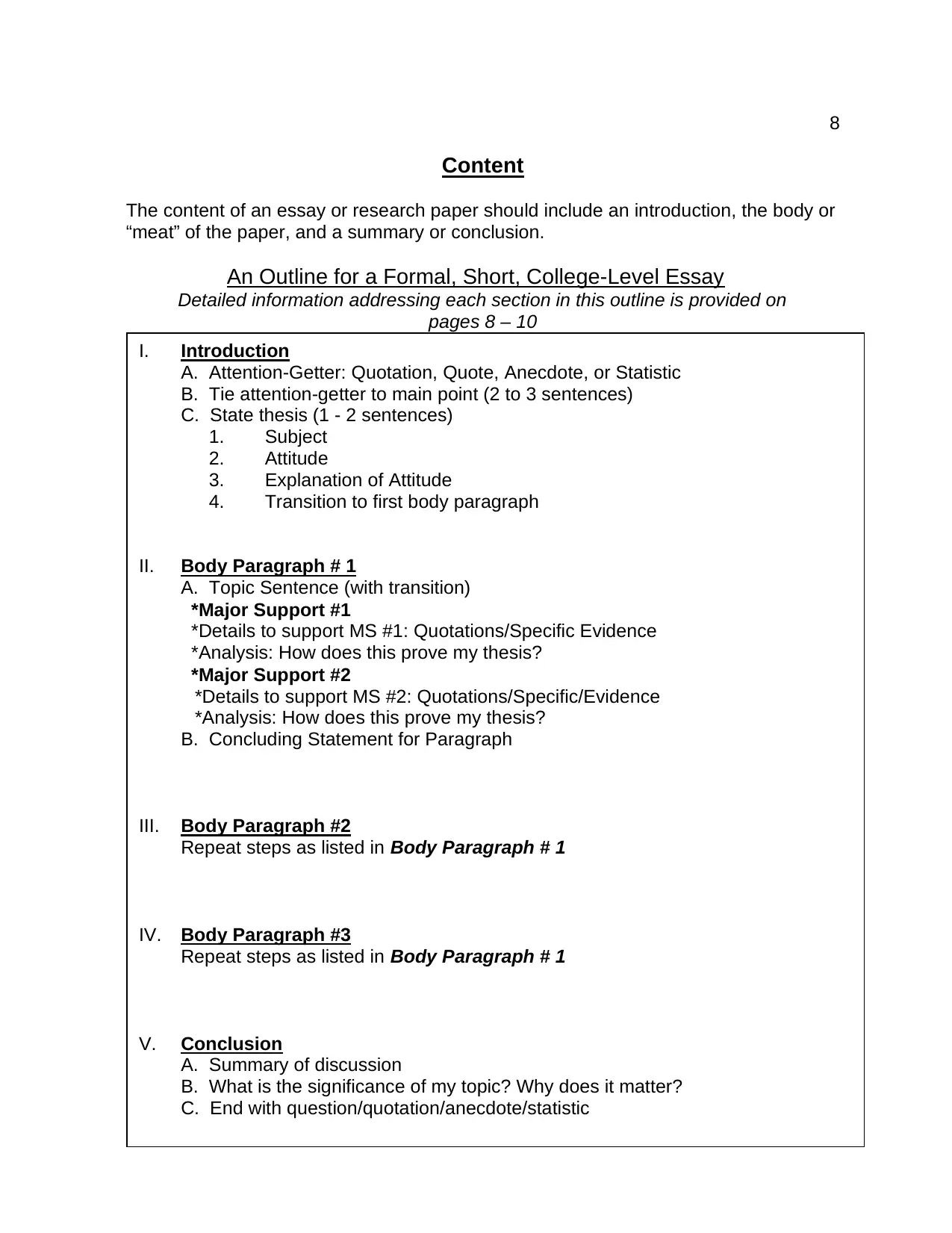
8
Content
The content of an essay or research paper should include an introduction, the body or
“meat” of the paper, and a summary or conclusion.
An Outline for a Formal, Short, College-Level Essay
Detailed information addressing each section in this outline is provided on
pages 8 – 10
I. Introduction
A. Attention-Getter: Quotation, Quote, Anecdote, or Statistic
B. Tie attention-getter to main point (2 to 3 sentences)
C. State thesis (1 - 2 sentences)
1. Subject
2. Attitude
3. Explanation of Attitude
4. Transition to first body paragraph
II. Body Paragraph # 1
A. Topic Sentence (with transition)
*Major Support #1
*Details to support MS #1: Quotations/Specific Evidence
*Analysis: How does this prove my thesis?
*Major Support #2
*Details to support MS #2: Quotations/Specific/Evidence
*Analysis: How does this prove my thesis?
B. Concluding Statement for Paragraph
III. Body Paragraph #2
Repeat steps as listed in Body Paragraph # 1
IV. Body Paragraph #3
Repeat steps as listed in Body Paragraph # 1
V. Conclusion
A. Summary of discussion
B. What is the significance of my topic? Why does it matter?
C. End with question/quotation/anecdote/statistic
Content
The content of an essay or research paper should include an introduction, the body or
“meat” of the paper, and a summary or conclusion.
An Outline for a Formal, Short, College-Level Essay
Detailed information addressing each section in this outline is provided on
pages 8 – 10
I. Introduction
A. Attention-Getter: Quotation, Quote, Anecdote, or Statistic
B. Tie attention-getter to main point (2 to 3 sentences)
C. State thesis (1 - 2 sentences)
1. Subject
2. Attitude
3. Explanation of Attitude
4. Transition to first body paragraph
II. Body Paragraph # 1
A. Topic Sentence (with transition)
*Major Support #1
*Details to support MS #1: Quotations/Specific Evidence
*Analysis: How does this prove my thesis?
*Major Support #2
*Details to support MS #2: Quotations/Specific/Evidence
*Analysis: How does this prove my thesis?
B. Concluding Statement for Paragraph
III. Body Paragraph #2
Repeat steps as listed in Body Paragraph # 1
IV. Body Paragraph #3
Repeat steps as listed in Body Paragraph # 1
V. Conclusion
A. Summary of discussion
B. What is the significance of my topic? Why does it matter?
C. End with question/quotation/anecdote/statistic
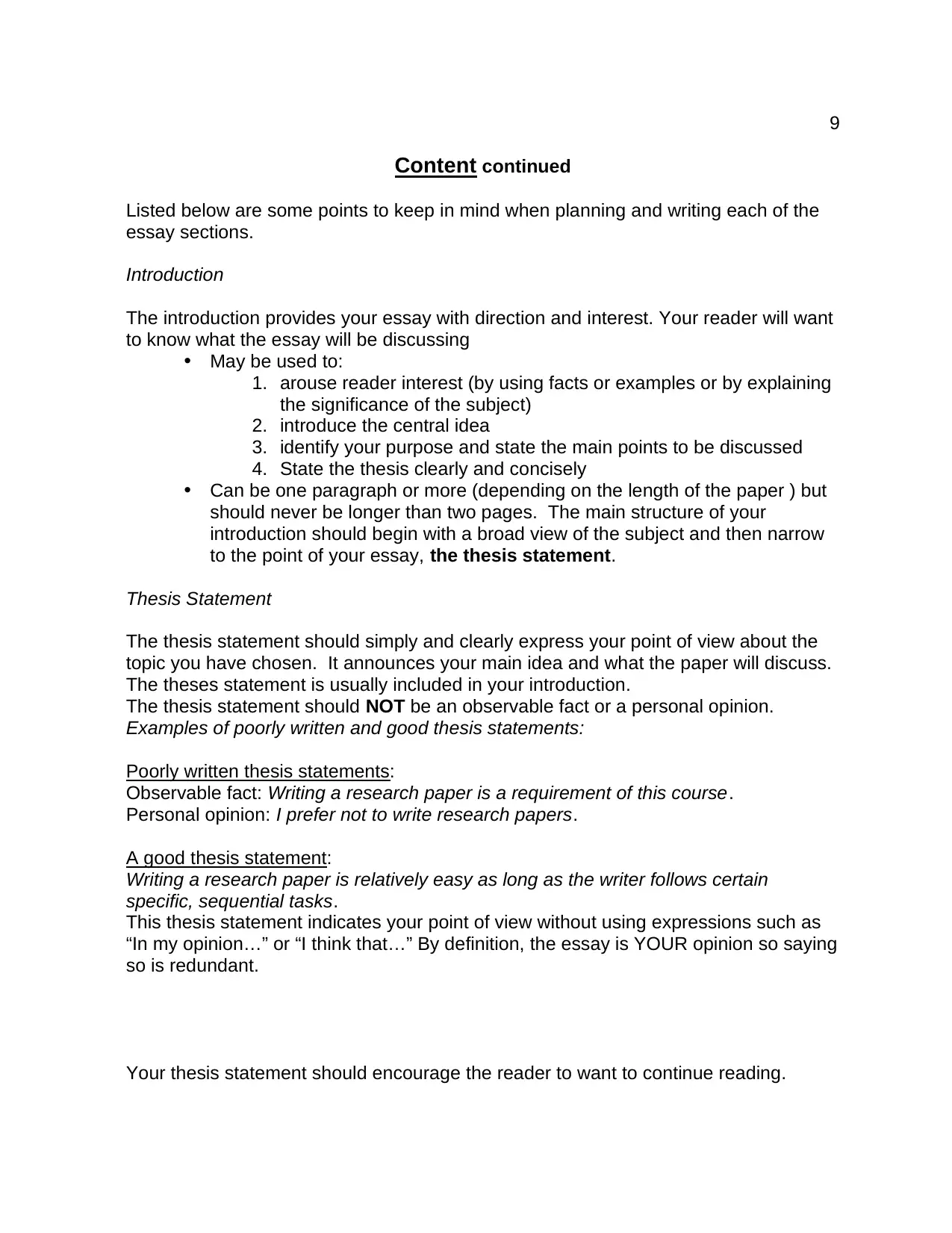
9
Content continued
Listed below are some points to keep in mind when planning and writing each of the
essay sections.
Introduction
The introduction provides your essay with direction and interest. Your reader will want
to know what the essay will be discussing
• May be used to:
1. arouse reader interest (by using facts or examples or by explaining
the significance of the subject)
2. introduce the central idea
3. identify your purpose and state the main points to be discussed
4. State the thesis clearly and concisely
• Can be one paragraph or more (depending on the length of the paper ) but
should never be longer than two pages. The main structure of your
introduction should begin with a broad view of the subject and then narrow
to the point of your essay, the thesis statement.
Thesis Statement
The thesis statement should simply and clearly express your point of view about the
topic you have chosen. It announces your main idea and what the paper will discuss.
The theses statement is usually included in your introduction.
The thesis statement should NOT be an observable fact or a personal opinion.
Examples of poorly written and good thesis statements:
Poorly written thesis statements:
Observable fact: Writing a research paper is a requirement of this course.
Personal opinion: I prefer not to write research papers.
A good thesis statement:
Writing a research paper is relatively easy as long as the writer follows certain
specific, sequential tasks.
This thesis statement indicates your point of view without using expressions such as
“In my opinion…” or “I think that…” By definition, the essay is YOUR opinion so saying
so is redundant.
Your thesis statement should encourage the reader to want to continue reading.
Content continued
Listed below are some points to keep in mind when planning and writing each of the
essay sections.
Introduction
The introduction provides your essay with direction and interest. Your reader will want
to know what the essay will be discussing
• May be used to:
1. arouse reader interest (by using facts or examples or by explaining
the significance of the subject)
2. introduce the central idea
3. identify your purpose and state the main points to be discussed
4. State the thesis clearly and concisely
• Can be one paragraph or more (depending on the length of the paper ) but
should never be longer than two pages. The main structure of your
introduction should begin with a broad view of the subject and then narrow
to the point of your essay, the thesis statement.
Thesis Statement
The thesis statement should simply and clearly express your point of view about the
topic you have chosen. It announces your main idea and what the paper will discuss.
The theses statement is usually included in your introduction.
The thesis statement should NOT be an observable fact or a personal opinion.
Examples of poorly written and good thesis statements:
Poorly written thesis statements:
Observable fact: Writing a research paper is a requirement of this course.
Personal opinion: I prefer not to write research papers.
A good thesis statement:
Writing a research paper is relatively easy as long as the writer follows certain
specific, sequential tasks.
This thesis statement indicates your point of view without using expressions such as
“In my opinion…” or “I think that…” By definition, the essay is YOUR opinion so saying
so is redundant.
Your thesis statement should encourage the reader to want to continue reading.
⊘ This is a preview!⊘
Do you want full access?
Subscribe today to unlock all pages.

Trusted by 1+ million students worldwide
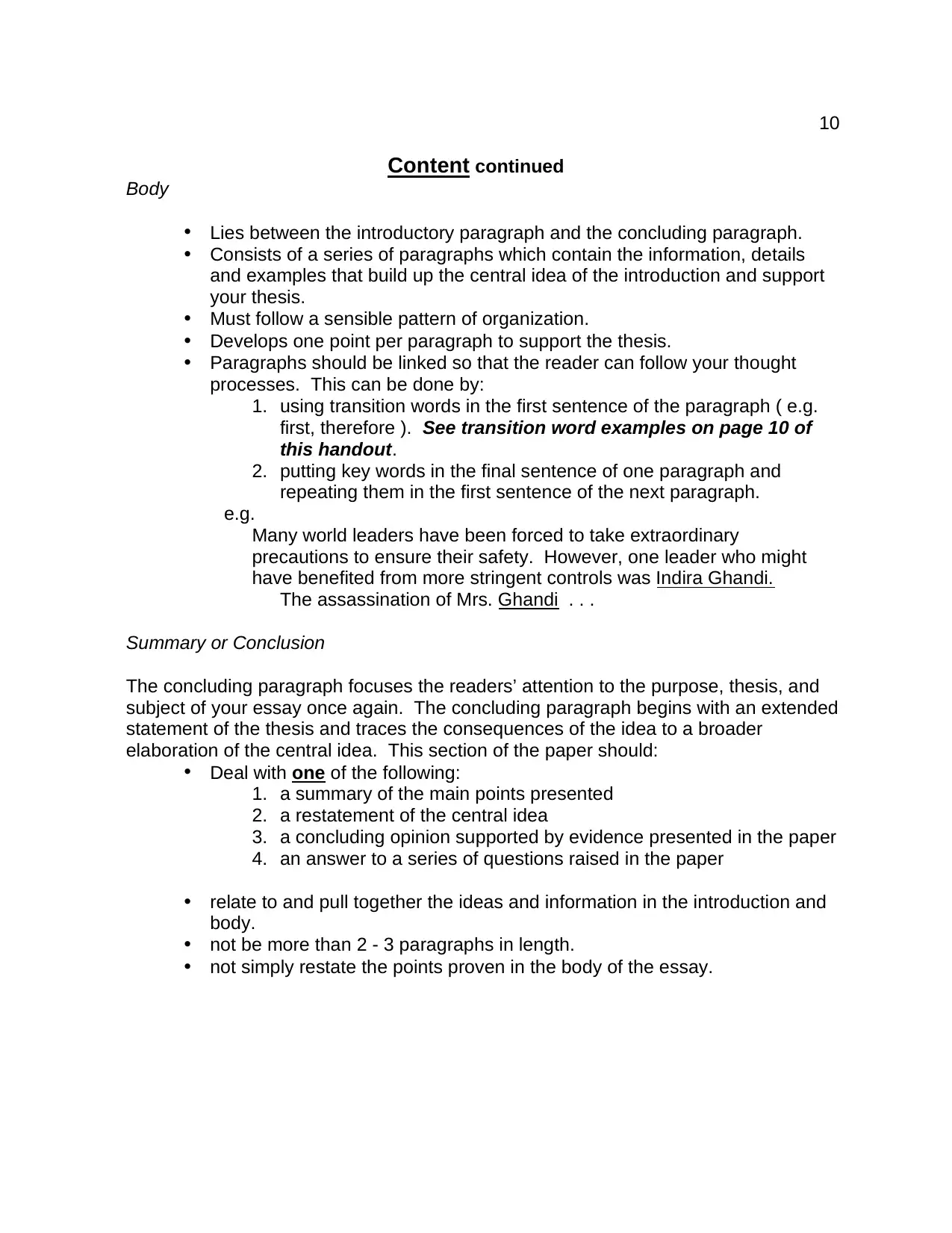
10
Content continued
Body
• Lies between the introductory paragraph and the concluding paragraph.
• Consists of a series of paragraphs which contain the information, details
and examples that build up the central idea of the introduction and support
your thesis.
• Must follow a sensible pattern of organization.
• Develops one point per paragraph to support the thesis.
• Paragraphs should be linked so that the reader can follow your thought
processes. This can be done by:
1. using transition words in the first sentence of the paragraph ( e.g.
first, therefore ). See transition word examples on page 10 of
this handout.
2. putting key words in the final sentence of one paragraph and
repeating them in the first sentence of the next paragraph.
e.g.
Many world leaders have been forced to take extraordinary
precautions to ensure their safety. However, one leader who might
have benefited from more stringent controls was Indira Ghandi.
The assassination of Mrs. Ghandi . . .
Summary or Conclusion
The concluding paragraph focuses the readers’ attention to the purpose, thesis, and
subject of your essay once again. The concluding paragraph begins with an extended
statement of the thesis and traces the consequences of the idea to a broader
elaboration of the central idea. This section of the paper should:
• Deal with one of the following:
1. a summary of the main points presented
2. a restatement of the central idea
3. a concluding opinion supported by evidence presented in the paper
4. an answer to a series of questions raised in the paper
• relate to and pull together the ideas and information in the introduction and
body.
• not be more than 2 - 3 paragraphs in length.
• not simply restate the points proven in the body of the essay.
Content continued
Body
• Lies between the introductory paragraph and the concluding paragraph.
• Consists of a series of paragraphs which contain the information, details
and examples that build up the central idea of the introduction and support
your thesis.
• Must follow a sensible pattern of organization.
• Develops one point per paragraph to support the thesis.
• Paragraphs should be linked so that the reader can follow your thought
processes. This can be done by:
1. using transition words in the first sentence of the paragraph ( e.g.
first, therefore ). See transition word examples on page 10 of
this handout.
2. putting key words in the final sentence of one paragraph and
repeating them in the first sentence of the next paragraph.
e.g.
Many world leaders have been forced to take extraordinary
precautions to ensure their safety. However, one leader who might
have benefited from more stringent controls was Indira Ghandi.
The assassination of Mrs. Ghandi . . .
Summary or Conclusion
The concluding paragraph focuses the readers’ attention to the purpose, thesis, and
subject of your essay once again. The concluding paragraph begins with an extended
statement of the thesis and traces the consequences of the idea to a broader
elaboration of the central idea. This section of the paper should:
• Deal with one of the following:
1. a summary of the main points presented
2. a restatement of the central idea
3. a concluding opinion supported by evidence presented in the paper
4. an answer to a series of questions raised in the paper
• relate to and pull together the ideas and information in the introduction and
body.
• not be more than 2 - 3 paragraphs in length.
• not simply restate the points proven in the body of the essay.
Paraphrase This Document
Need a fresh take? Get an instant paraphrase of this document with our AI Paraphraser

11
Content continued
Summary or Conclusion continued
There are several ways of ending an essay:
a) summary of ideas with suggestions for further study
b) personal evaluation of the ideas presented
c) appropriate quotation and comment about the significance of the paper
d) extension of thesis but no new material which has not been hinted at
earlier
Transitional Words
Transitional (linking) words are used to connect ideas from one paragraph to another as
well as relate one sentence to another within a paragraph. Transitional words show the
relevance of, and relationship between paragraphs.
1. TO INDICATE AN ADDITIONAL POINT, you could use:
also, in addition, equally important, another, as well as, not only…but also,
besides, in addition to..., furthermore, together with
2. TO INDICATE AN EXAMPLE, you could use:
for instance, for example, to illustrate…, some…, other…, one…, another
3. TO INDICATE A SEQUENCE, you could use:
First, second, next, last, finally, then, currently, now, in the past, in the
future, after a few days/hours/minutes, etc., before…, after…, soon
4. TO INDICATE A SIMILAR IDEA, you could use:
similarly, in the same manner, in comparison, likewise,
identical/identically, equal/equally, equivalent
5. TO INDICATE A CONTRASTING IDEA, you could use:
however, on the other hand, but, on the contrary, although this may be
true…, conversely, not the same, different…, opposite…, the reverse…,
unequal, in spite of…, differs from…
Content continued
Summary or Conclusion continued
There are several ways of ending an essay:
a) summary of ideas with suggestions for further study
b) personal evaluation of the ideas presented
c) appropriate quotation and comment about the significance of the paper
d) extension of thesis but no new material which has not been hinted at
earlier
Transitional Words
Transitional (linking) words are used to connect ideas from one paragraph to another as
well as relate one sentence to another within a paragraph. Transitional words show the
relevance of, and relationship between paragraphs.
1. TO INDICATE AN ADDITIONAL POINT, you could use:
also, in addition, equally important, another, as well as, not only…but also,
besides, in addition to..., furthermore, together with
2. TO INDICATE AN EXAMPLE, you could use:
for instance, for example, to illustrate…, some…, other…, one…, another
3. TO INDICATE A SEQUENCE, you could use:
First, second, next, last, finally, then, currently, now, in the past, in the
future, after a few days/hours/minutes, etc., before…, after…, soon
4. TO INDICATE A SIMILAR IDEA, you could use:
similarly, in the same manner, in comparison, likewise,
identical/identically, equal/equally, equivalent
5. TO INDICATE A CONTRASTING IDEA, you could use:
however, on the other hand, but, on the contrary, although this may be
true…, conversely, not the same, different…, opposite…, the reverse…,
unequal, in spite of…, differs from…
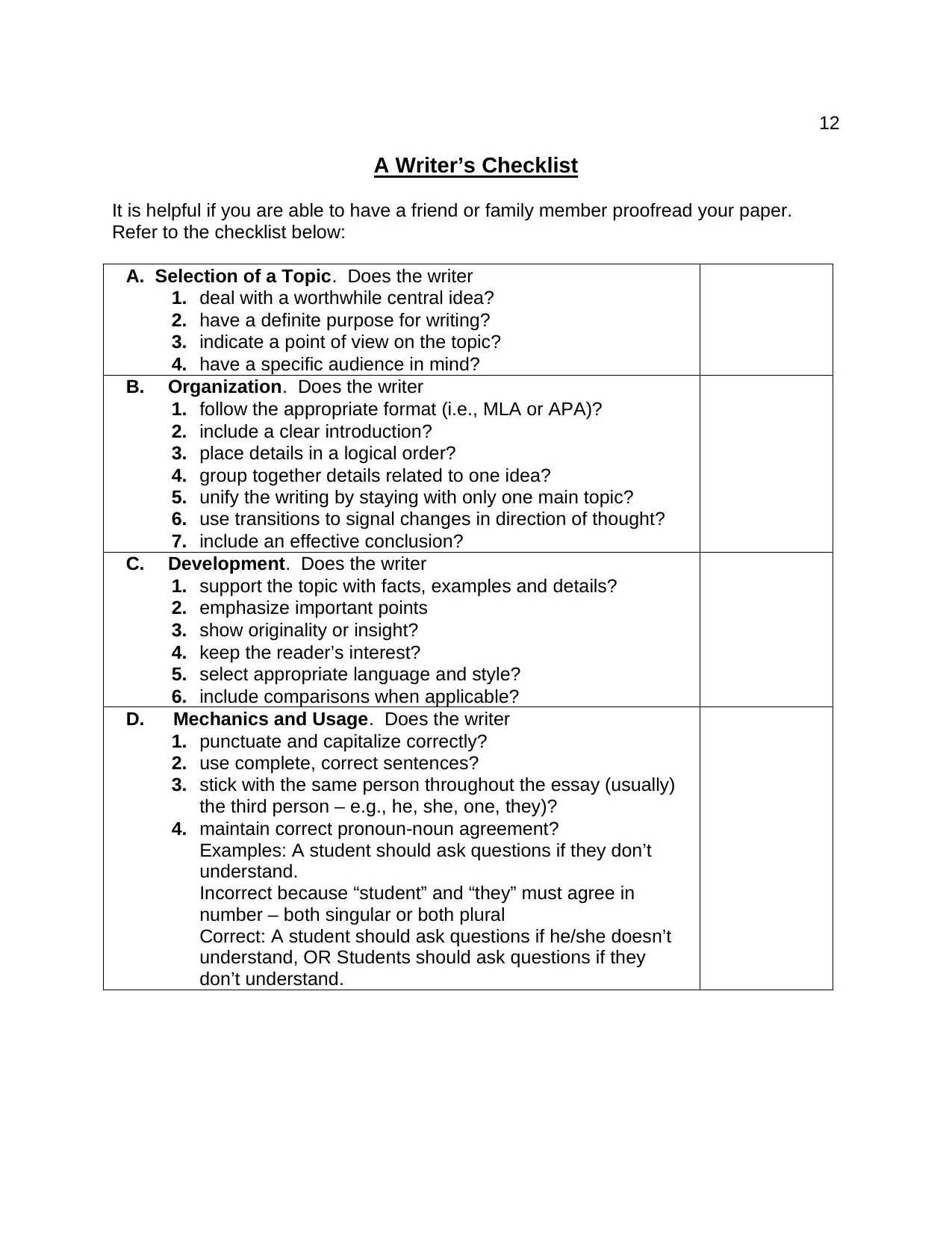
12
A Writer’s Checklist
It is helpful if you are able to have a friend or family member proofread your paper.
Refer to the checklist below:
A. Selection of a Topic. Does the writer
1. deal with a worthwhile central idea?
2. have a definite purpose for writing?
3. indicate a point of view on the topic?
4. have a specific audience in mind?
B. Organization. Does the writer
1. follow the appropriate format (i.e., MLA or APA)?
2. include a clear introduction?
3. place details in a logical order?
4. group together details related to one idea?
5. unify the writing by staying with only one main topic?
6. use transitions to signal changes in direction of thought?
7. include an effective conclusion?
C. Development. Does the writer
1. support the topic with facts, examples and details?
2. emphasize important points
3. show originality or insight?
4. keep the reader’s interest?
5. select appropriate language and style?
6. include comparisons when applicable?
D. Mechanics and Usage. Does the writer
1. punctuate and capitalize correctly?
2. use complete, correct sentences?
3. stick with the same person throughout the essay (usually)
the third person – e.g., he, she, one, they)?
4. maintain correct pronoun-noun agreement?
Examples: A student should ask questions if they don’t
understand.
Incorrect because “student” and “they” must agree in
number – both singular or both plural
Correct: A student should ask questions if he/she doesn’t
understand, OR Students should ask questions if they
don’t understand.
A Writer’s Checklist
It is helpful if you are able to have a friend or family member proofread your paper.
Refer to the checklist below:
A. Selection of a Topic. Does the writer
1. deal with a worthwhile central idea?
2. have a definite purpose for writing?
3. indicate a point of view on the topic?
4. have a specific audience in mind?
B. Organization. Does the writer
1. follow the appropriate format (i.e., MLA or APA)?
2. include a clear introduction?
3. place details in a logical order?
4. group together details related to one idea?
5. unify the writing by staying with only one main topic?
6. use transitions to signal changes in direction of thought?
7. include an effective conclusion?
C. Development. Does the writer
1. support the topic with facts, examples and details?
2. emphasize important points
3. show originality or insight?
4. keep the reader’s interest?
5. select appropriate language and style?
6. include comparisons when applicable?
D. Mechanics and Usage. Does the writer
1. punctuate and capitalize correctly?
2. use complete, correct sentences?
3. stick with the same person throughout the essay (usually)
the third person – e.g., he, she, one, they)?
4. maintain correct pronoun-noun agreement?
Examples: A student should ask questions if they don’t
understand.
Incorrect because “student” and “they” must agree in
number – both singular or both plural
Correct: A student should ask questions if he/she doesn’t
understand, OR Students should ask questions if they
don’t understand.
⊘ This is a preview!⊘
Do you want full access?
Subscribe today to unlock all pages.

Trusted by 1+ million students worldwide
1 out of 20
Related Documents
Your All-in-One AI-Powered Toolkit for Academic Success.
+13062052269
info@desklib.com
Available 24*7 on WhatsApp / Email
![[object Object]](/_next/static/media/star-bottom.7253800d.svg)
Unlock your academic potential
Copyright © 2020–2025 A2Z Services. All Rights Reserved. Developed and managed by ZUCOL.





